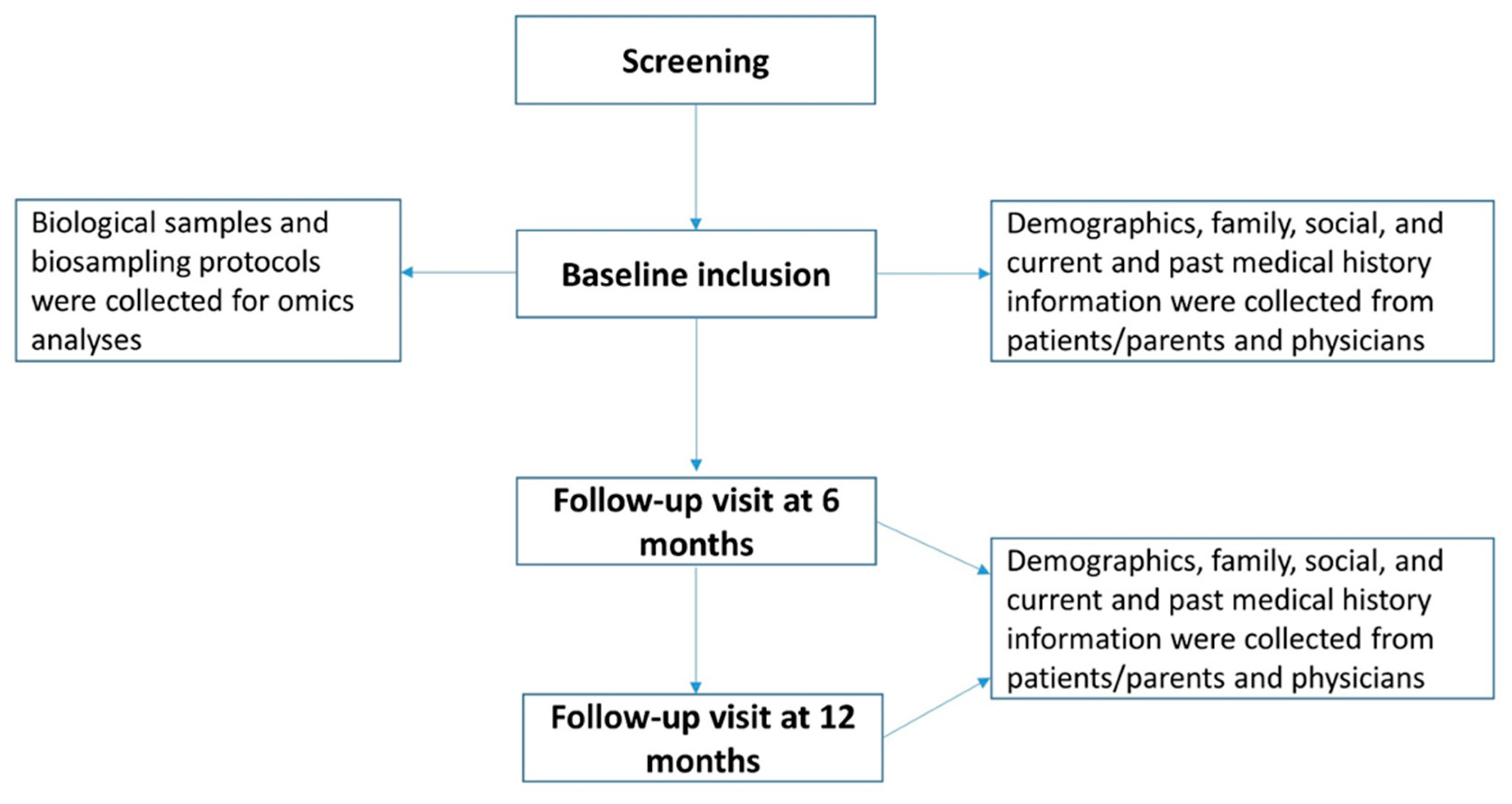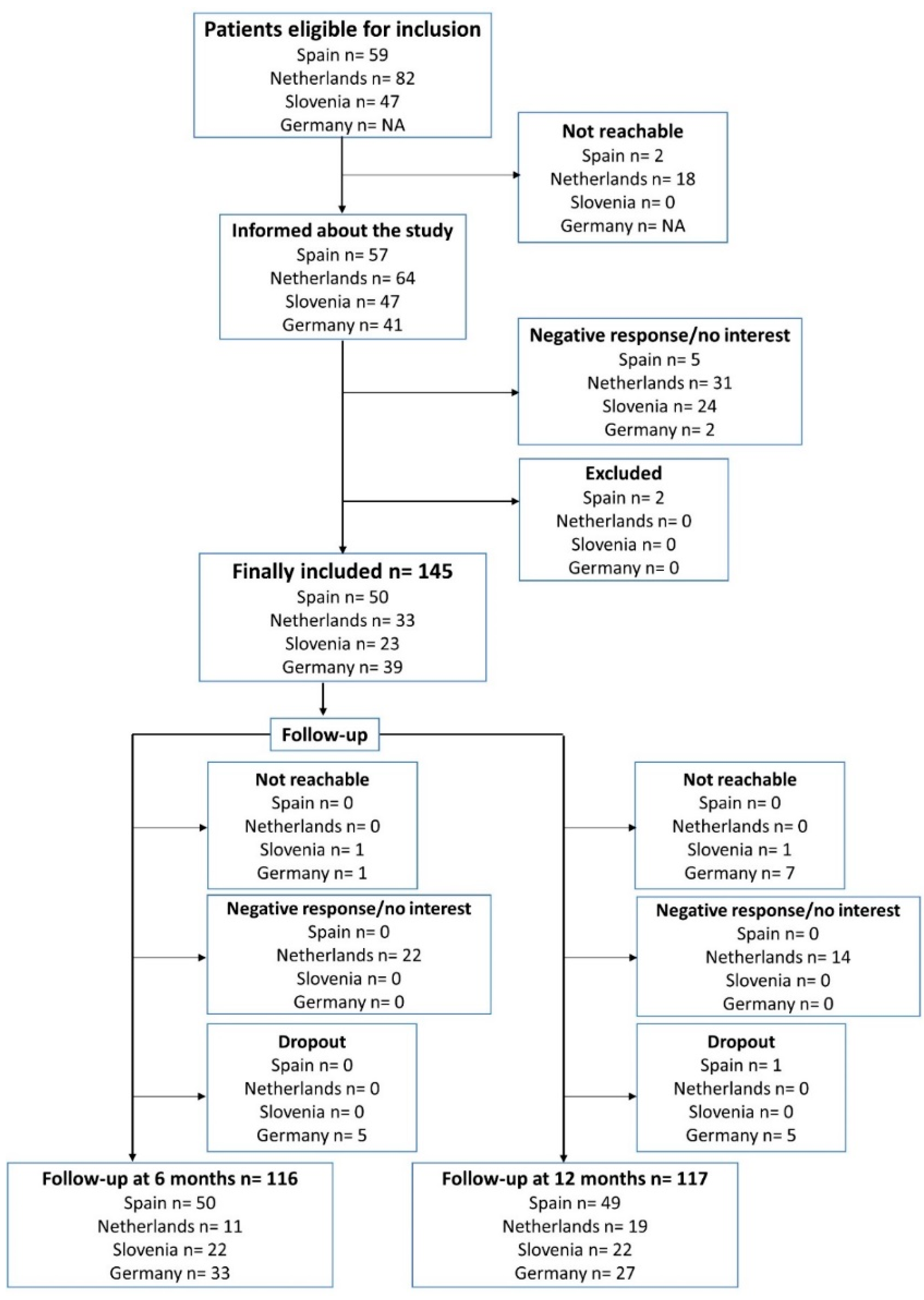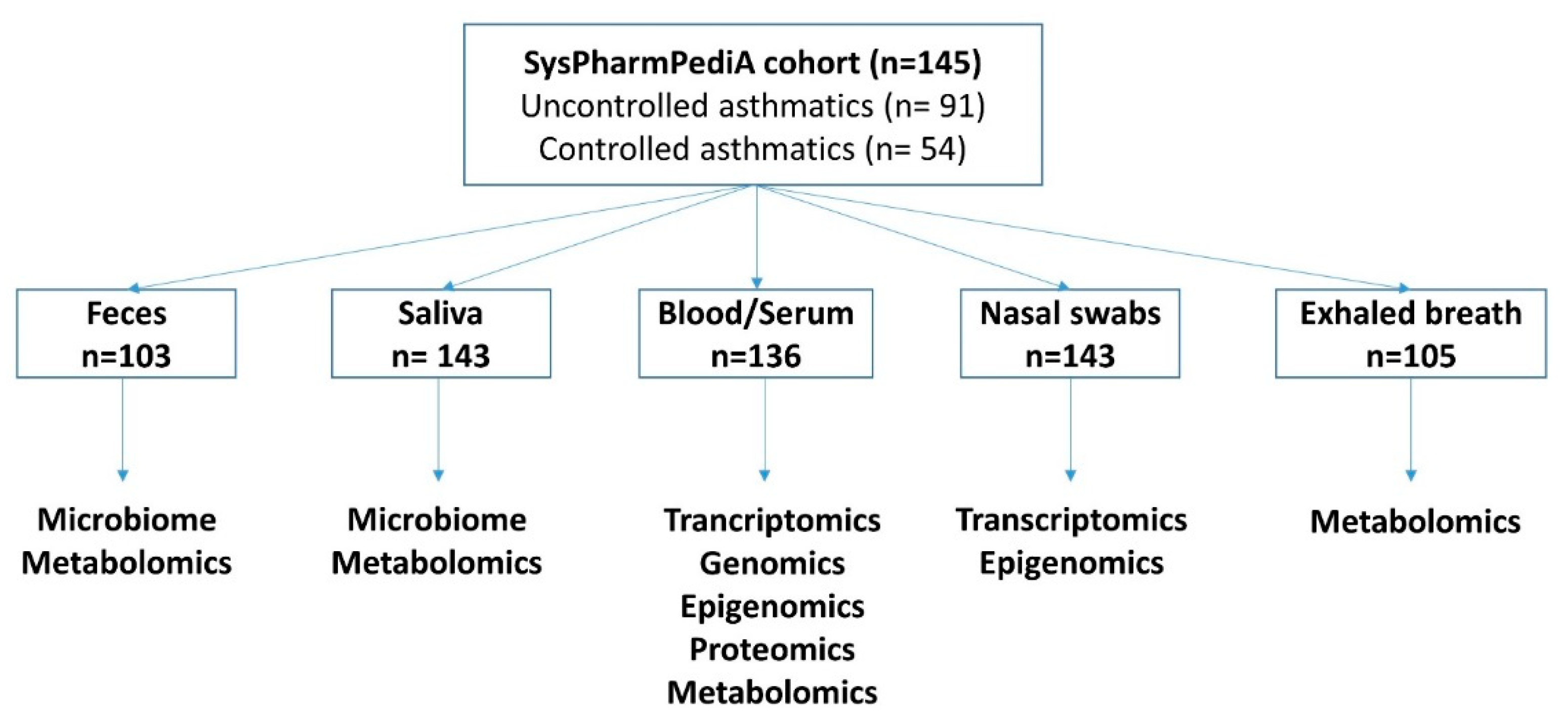A System Pharmacology Multi-Omics Approach toward Uncontrolled Pediatric Asthma
Abstract
1. Introduction
2. Materials and Methods
2.1. Study Design
2.2. Eligibility Criteria and Main Outcome Definition
2.3. Demographics and Clinical Assessment
2.4. Atopic Sensitization Assessment
2.5. Spirometry Measurements
2.6. Fractional Exhaled Nitric Oxide
2.7. Biosample Collection for Omics Analyses
2.8. Data Collection in STOPPA
2.9. Platforms of Omics Analyses
2.10. Follow-Up Assessment
2.11. Sample Size Calculation
2.12. Data Management and Statistics
2.13. Statistical Analyses
3. Results
4. Discussion
- The establishment of a multicenter multi-omics project in children with severe uncontrolled asthma has large personnel and computational facility requirements.
- Advances in high-throughput omics technologies (and the relatively low costs of omics analyses nowadays), allow multi-omics projects to become more and more feasible compared with the last decade.
- The relatively small number of children with severe asthma (2–10% of the total childhood asthma population) makes the recruitment of such a unique cohort quite a challenging task and requires collaboration between multiple study centers from multiple countries.
- Differences in medical/ethical legislations and regulations in different European countries make study preparations difficult and often compromise study uniformity.
- Obtaining ethical approval in several different European countries is time consuming and, therefore, enough time should be scheduled for this in advance.
- The recruitment can be hindered by the unwillingness of study participants and/or their guardians to provide multiple samples from multiple body compartments and/or by being uncomfortable to provide specific types of samples (e.g., feces and blood).
- Using standardized operating procedures (SOPs) and protocols guarantees the uniform methodological conduct and appropriate handling, storage, and processing of samples.
- Working under a harmonized work frame and using a validated database system to handle questionnaires and documents in different languages is important to ensure delivery of the study objectives.
- Using a centralized biobank is necessary to unify methodological conducts and omics measurements.
- Recent European regulations, such as the EU General Data Protection Regulation (GDPR), might influence decisions/actions related to omics and data sharing between countries and study centers.
- Differences in the origin (nationality and/or ethnicity) of the recruited participants are favorable to reach more generalizable findings and/or conclusions from the study. However, this can also come at the expense of higher variability in confounding factors, such as different environments of exposure, dietary habits, and genetic background of the recruited subjects.
- A project coordinator who routinely organizes monthly/bi-monthly online meetings with all study partners to discuss current status, study progress, and how to overcome challenges in a timely manner is crucial.
- Aside from principal investigators within a project, it is important to also involve young researchers with hands-on practical experience within each and every team, who can provide input on the content of the study, apart from executing practical tasks related to the project.
- Yearly face-to-face meetings at the different study locations (each time hosted by another partner within the consortium) are essential for the good collaboration within such an international project. This allows all cooperating partners within the project to witness directly how the setting of the respective clinical study center is being adapted for the needs of the particular project.
Supplementary Materials
Author Contributions
Funding
Institutional Review Board Statement
Informed Consent Statement
Data Availability Statement
Acknowledgments
Conflicts of Interest
References
- The Global Asthma Report 2018; Global Asthma Network: Auckland, New Zealand, 2018.
- Asher, I.; Pearce, N. Global burden of asthma among children. Int. J. Tuberc. Lung Dis. 2014, 18, 1269–1278. [Google Scholar] [CrossRef]
- Kelly, H.W.; Sternberg, A.L.; Lescher, R.; Fuhlbrigge, A.L.; Williams, P.; Zeiger, R.; Raissy, H.H.; Van Natta, M.L.; Tonascia, J.; Strunk, R.C. Effect of Inhaled Glucocorticoids in Childhood on Adult Height. N. Engl. J. Med. 2012, 367, 904–912. [Google Scholar] [CrossRef]
- Ramratnam, S.K.; Bacharier, L.B.; Guilbert, T.W. Severe Asthma in Children. J. Allergy Clin. Immunol. Pract. 2017, 5, 889–898. [Google Scholar] [CrossRef] [PubMed]
- Pijnenburg, M.W.; Fleming, L. Advances in understanding and reducing the burden of severe asthma in children. Lancet Respir. Med. 2020, 8, 1032–1044. [Google Scholar] [CrossRef]
- Ferrante, G.; La Grutta, S. The Burden of Pediatric Asthma. Front. Pediatr. 2018, 6, 186. [Google Scholar] [CrossRef] [PubMed]
- Licari, A.; Castagnoli, R.; Brambilla, I.; Marseglia, A.; Tosca, M.A.; Marseglia, G.L.; Ciprandi, G. Asthma Endotyping and Biomarkers in Childhood Asthma. Pediatr. Allergy Immunol. Pulmonol. 2018, 31, 44–55. [Google Scholar] [CrossRef]
- Vijverberg, S.J.; Brinkman, P.; Rutjes, N.W.; Der Zee, A.H.M.-V. Precision medicine in severe pediatric asthma. Curr. Opin. Pulm. Med. 2020, 26, 77–83. [Google Scholar] [CrossRef]
- Abdel-Aziz, M.I.; Neerincx, A.H.; Vijverberg, S.J.; Kraneveld, A.D.; Der Zee, A.H.M.-V. Omics for the future in asthma. Semin. Immunopathol. 2020, 42, 111–126. [Google Scholar] [CrossRef] [PubMed]
- Fleming, L.; Murray, C.; Bansal, A.T.; Hashimoto, S.; Bisgaard, H.; Bush, A.; Frey, U.; Hedlin, G.; Singer, F.; Van Aalderen, W.M.; et al. The burden of severe asthma in childhood and adolescence: Results from the paediatric U-BIOPRED cohorts. Eur. Respir. J. 2015, 46, 1322–1333. [Google Scholar] [CrossRef] [PubMed]
- Fitzpatrick, A.M.; Higgins, M.; Holguin, F.; Brown, L.A.S.; Teague, W.G. The molecular phenotype of severe asthma in children. J. Allergy Clin. Immunol. 2010, 125, 851–857.e18. [Google Scholar] [CrossRef]
- Teague, W.G.; Phillips, B.R.; Fahy, J.V.; Wenzel, S.; Fitzpatrick, A.M.; Moore, W.C.; Hastie, A.T.; Bleecker, E.R.; Meyers, D.A.; Peters, S.P.; et al. Baseline Features of the Severe Asthma Research Program (SARP III) Cohort: Differences with Age. J. Allergy Clin. Immunol. Pract. 2018, 6, 545–554.e4. [Google Scholar] [CrossRef]
- Global Initiative for Asthma. Global Strategy for Asthma Management and Prevention. Available online: www.ginasthma.org (accessed on 1 December 2016).
- Nathan, R.A.; Sorkness, C.A.; Kosinski, M.; Schatz, M.; Li, J.T.; Marcus, P.; Murray, J.J.; Pendergraft, T.B. Development of the asthma control test: A survey for assessing asthma control. J. Allergy Clin. Immunol. 2004, 113, 59–65. [Google Scholar] [CrossRef] [PubMed]
- Liu, A.H.; Zeiger, R.; Sorkness, C.; Mahr, T.; Ostrom, N.; Burgess, S.; Rosenzweig, J.C.; Manjunath, R. Development and cross-sectional validation of the Childhood Asthma Control Test. J. Allergy Clin. Immunol. 2007, 119, 817–825. [Google Scholar] [CrossRef]
- Juniper, E.F.; Guyatt, G.H.; Feeny, D.H.; Ferrie, P.J.; Griffith, L.E.; Townsend, M. Measuring quality of life in children with asthma. Qual. Life Res. 1996, 5, 35–46. [Google Scholar] [CrossRef] [PubMed]
- Cohen, J.L.; Mann, D.M.; Wisnivesky, J.P.; Horne, R.; Leventhal, H.; Musumeci-Szabó, T.J.; Halm, E.A. Assessing the validity of self-reported medication adherence among inner-city asthmatic adults: The Medication Adherence Report Scale for Asthma. Ann. Allergy Asthma Immunol. 2009, 103, 325–331. [Google Scholar] [CrossRef]
- Van Der Palen, J.; Thomas, M.; Chrystyn, H.; Sharma, R.K.; Van Der Valk, P.D.; Goosens, M.; Wilkinson, T.; Stonham, C.; Chauhan, A.J.; Imber, V.; et al. A randomised open-label cross-over study of inhaler errors, preference and time to achieve correct inhaler use in patients with COPD or asthma: Comparison of ELLIPTA with other inhaler devices. Prim. Care Respir. Med. 2016, 26, 16079. [Google Scholar] [CrossRef] [PubMed]
- Miller, M.R.; Hankinson, J.; Brusasco, V.; Burgos, F.; Casaburi, R.; Coates, A.; Crapo, R.; Enright, P.; Van Der Grinten, C.P.M.; Gustafsson, P.; et al. Standardisation of spirometry. Eur. Respir. J. 2005, 26, 319–338. [Google Scholar] [CrossRef]
- Quanjer, P.; Stanojevic, S.; Cole, T.; Baur, X.; Hall, G.; Culver, B.; Enright, P.; Hankinson, J.L.; Ip, M.S.; Zheng, J.; et al. Multi-ethnic reference values for spirometry for the 3–95-yr age range: The global lung function 2012 equations. Eur. Respir. J. 2012, 40, 1324–1343. [Google Scholar] [CrossRef]
- American Thoracic Society; European Respiratory Society. ATS/ERS Recommendations for Standardized Procedures for the Online and Offline Measurement of Exhaled Lower Respiratory Nitric Oxide and Nasal Nitric Oxide. Am. J. Respir. Crit. Care Med. 2005, 171, 912–930. [Google Scholar] [CrossRef] [PubMed]
- Almqvist, C.; Örtqvist, A.K.; Ullemar, V.; Lundholm, C.; Lichtenstein, P.; Magnusson, P.K.E. Cohort Profile: Swedish Twin Study on Prediction and Prevention of Asthma (STOPPA). Twin Res. Hum. Genet. 2015, 18, 273–280. [Google Scholar] [CrossRef] [PubMed]
- La Rosa, P.S.; Brooks, J.P.; Deych, E.; Boone, E.L.; Edwards, D.J.; Wang, Q.; Sodergren, E.; Weinstock, G.; Shannon, W.D. Hypothesis Testing and Power Calculations for Taxonomic-Based Human Microbiome Data. PLoS ONE 2012, 7, e52078. [Google Scholar] [CrossRef] [PubMed]
- Tsai, P.-C.; Bell, J.T. Power and sample size estimation for epigenome-wide association scans to detect differential DNA methylation. Int. J. Epidemiol. 2015, 44, 1429–1441. [Google Scholar] [CrossRef] [PubMed]
- Wysocki, K.; Conley, Y.; Wenzel, S. Epigenome Variation in Severe Asthma. Biol. Res. Nurs. 2015, 17, 263–269. [Google Scholar] [CrossRef] [PubMed][Green Version]
- Vijverberg, S.; Brinkman, P.; Raaijmakers, J.; van der Ent, K.; Sterk, P.; der Zee, A.M.; Koenderman, L. Asthmatic children that are uncontrolled despite inhaled corticosteroids have a distinct breathprint (the pacman2 study). Clin. Transl. Allergy 2015, 5, O6. [Google Scholar] [CrossRef]
- The KUNO-Kids Study Group; Brandstetter, S.; Toncheva, A.A.; Niggel, J.; Wolff, C.; Gran, S.; Seelbach-Göbel, B.; Apfelbacher, C.; Melter, M.; Kabesch, M.; et al. KUNO-Kids birth cohort study: Rationale, design, and cohort description. Mol. Cell. Pediatr. 2019, 6, 1. [Google Scholar] [CrossRef]
- De Onis, M.; Onyango, A.W.; Borghi, E.; Siyam, A.; Nishida, C.; Siekmann, J. Development of a WHO growth reference for school-aged children and adolescents. Bull. World Health Organ. 2007, 85, 660–667. [Google Scholar] [CrossRef]
- R Core Team. R: A Language and Environment for Statistical Computing; R Foundation for Statistical Computing: Vienna, Austria, 2020. [Google Scholar]
- Subramanian, I.; Verma, S.; Kumar, S.; Jere, A.; Anamika, K. Multi-omics Data Integration, Interpretation, and Its Application. Bioinform. Biol. Insights 2020, 14, 1177932219899051. [Google Scholar] [CrossRef]
- Li, C.-X.; Wheelock, C.E.; Sköld, C.M.; Wheelock, Å.M. Integration of multi-omics datasets enables molecular classification of COPD. Eur. Respir. J. 2018, 51, 1701930. [Google Scholar] [CrossRef]
- Dharmage, S.C.; Perret, J.L.; Custovic, A. Epidemiology of Asthma in Children and Adults. Front. Pediatr. 2019, 7, 246. [Google Scholar] [CrossRef]
- Kristman, V.; Manno, M.; Côté, P. Loss to Follow-Up in Cohort Studies: How Much is Too Much? Eur. J. Epidemiol. 2003, 19, 751–760. [Google Scholar] [CrossRef]
- The EU General Data Protection Regulation (GDPR). Available online: https://eugdpr.org/ (accessed on 17 June 2019).
- BBMRI-ERIC Common Service ELSI. The EU General Data Protection Regulation. Answers to Frequently Asked Questions (Version 2.0). Available online: http://www.bbmri-eric.eu/wp-content/uploads/BBMRI-ERIC_FAQs_on_the_GDPR_V2.0.pdf (accessed on 17 June 2019).



| Characteristics (SysPharmPediA) | All Recruited Subjects (n = 145) | Uncontrolled Asthmatics (n = 91) | Controlled Asthmatics (n = 54) |
|---|---|---|---|
| Age in years, median (IQR) | 11.93 (9.65, 14.00) | 12.00 (9.68, 14.00) | 11.74 (9.65, 13.84) |
| Female, n (%) | 59/145 (41%) | 39/91 (43%) | 20/54 (37%) |
| Ethnicity, n (%) # | |||
| 115/145 (79%) | 65/91 (71%) | 50/54 (93%) |
| 10/145 (7%) | 7/91 (8%) | 3/54 (6%) |
| 6/145 (4%) | 6/91 (7%) | 0/54 (0%) |
| 2/145 (1%) | 1/91 (1%) | 1/54 (2%) |
| 12/145 (8%) | 12/91 (13%) | 0/54 (0%) |
| BMI z-score, median (IQR) | 0.57 (−0.35, 1.38) (n = 144) | 0.50 (−0.30, 1.43) (n = 90) | 0.74 (−0.45, 1.27) (n = 54) |
| Cesarean section, n (%) | 27/139 (19%) | 15/86 (17%) | 12/53 (23%) |
| Breast feeding, duration in months, median (IQR) | 4.00 (0.00, 9.00) (n = 137) | 5.50 (0.00, 9.00) (n = 86) | 4.00 (1.00, 9.00) (n = 51) |
| Current living environment, n (%) ## | |||
| 58/140 (41%) | 43/87 (49%) | 15/53 (28%) |
| 11/140 (8%) | 8/87 (9%) | 3/53 (6%) |
| 18/140 (13%) | 11/87 (13%) | 7/53 (13%) |
| 53/140 (38%) | 25/87 (29%) | 28/53 (53%) |
| Active and/or passive smoking exposure during pregnancy, n (%) | 35/130 (27%) | 20/79 (25%) | 15/51 (29%) |
| Current active/passive smoking, n (%) | 42/138 (30%) | 26/87 (30%) | 16/51 (31%) |
| Country of inclusion, n (%) | |||
| 50/145 (34%) | 35/91 (38%) | 15/54 (28%) |
| 39/145 (27%) | 20/91 (22%) | 19/54 (35%) |
| 33/145 (23%) | 26/91 (29%) | 7/54 (13%) |
| 23/145 (16%) | 10/91 (11%) | 13/54 (24%) |
| Atopy, n (%) | 121/138 (88%) | 76/85 (89%) | 45/53 (85%) |
| Diagnosed allergic rhinitis (ever), n (%) | 101/137 (74%) | 62/85 (73%) | 39/52 (75%) |
| Diagnosed allergic conjunctivitis (ever), n (%) | 87/134 (65%) | 55/83 (66%) | 32/51 (63%) |
| Asthma Control Test (ACT), median (IQR) | 23.00 (19.00, 25.00) (n = 140) | 20.00 (17.00, 23.00) (n = 88) | 24.50 (23.00, 25.00) (n = 52) |
| Current asthma medication intake §, n (%) | |||
| 145/145 (100%) | 91/91 (100%) | 54/54 (100%) |
| 133/142 (94%) | 85/89 (96%) | 48/53 (91%) |
| 134/143 (94%) | 83/90 (92%) | 51/53 (96%) |
| 31/137 (23%) | 30/84 (36%) | 1/53 (2%) |
| 25/131 (19%) | 18/84 (21%) | 7/47 (15%) |
| 14/139 (10%) | 13/86 (15%) | 1/53 (2%) |
| 2/137 (1%) | 2/85 (2%) | 0/52 (0%) |
| Spirometry % predicted, median (IQR) | |||
| 94.01 (82.74, 102.96) (n = 142) | 95.20 (82.05, 102.18) (n = 89) | 92.64 (86.08, 103.26) (n = 53) |
| 99.40 (89.97, 108.76) (n = 140) | 99.66 (91.90, 108.01) (n = 88) | 97.63 (89.44, 109.35) (n = 52) |
| 95.42 (87.20, 100.38) (n = 142) | 94.05 (85.85, 98.99) (n = 89) | 97.25 (89.24, 102.76) (n = 53) |
| 99.31 (92.35, 103.56) (n = 140) | 98.79 (90.58, 103.69) (n = 89) | 99.86 (94.64, 103.51) (n = 52) |
| Spirometry z-score, median (IQR) | |||
| −0.49 (−1.44, 0.26) (n = 142) | −0.40 (−1.55, 0.20) (n = 89) | −0.63 (−1.18, 0.28) (n = 53) |
| −0.05 (−0.84, 0.73) (n = 140) | −0.03 (−0.68, 0.69) (n = 88) | −0.20 (−0.90, 0.75) (n = 52) |
| −0.68 (−1.65, 0.06) (n = 142) | −0.89 (−1.84, −0.15) (n = 89) | −0.42 (−1.52, 0.41) (n = 53) |
| −0.10 (−1.05, 0.56) (n = 140) | −0.18 (−1.28, 0.59) (n = 88) | −0.02 (−0.77, 0.55) (n = 52) |
| FENO (ppb), median (IQR) | 16.35 (8.88, 41.25) (n = 124) | 21.70 (11.00, 50.38) (n = 80) | 10.50 (6.53, 17.18) (n = 44) |
| Whole-blood cellular counts (absolute count × 109/L), median (IQR) | |||
| 0.37 (0.21, 0.62) (n = 126) | 0.46 (0.23, 0.74) (n = 80) | 0.35 (0.18, 0.45) (n = 46) |
| 3.27 (2.43, 4.24) (n = 126) | 3.31 (2.44, 4.30) (n = 80) | 3.20 (2.40, 4.04) (n = 46) |
| 2.58 (2.23, 3.10) (n = 126) | 2.71 (2.23, 3.24) (n = 80) | 2.51 (2.21, 2.90) (n = 46) |
| 0.04 (0.03, 0.06) (n = 126) | 0.04 (0.03, 0.06) (n = 80) | 0.04 (0.02, 0.06) (n = 46) |
| 0.53 (0.41, 0.66) (n = 126) | 0.53 (0.41, 0.66) (n = 80) | 0.54 (0.43, 0.65) (n = 46) |
| 7.16 (5.79, 8.40) (n = 128) | 7.30 (5.95, 9.09) (n = 82) | 6.99 (5.71, 7.60) (n = 46) |
| 4.97 (4.64, 5.48) (n = 126) | 5.04 (4.60, 7.58) (n = 80) | 4.83 (4.69, 5.02) (n = 46) |
| 278.00 (250.50, 338.50) (n = 127) | 277.00 (253.00, 349.00) (n = 81) | 278.50 (243.75, 324.50) (n = 46) |
Publisher’s Note: MDPI stays neutral with regard to jurisdictional claims in published maps and institutional affiliations. |
© 2021 by the authors. Licensee MDPI, Basel, Switzerland. This article is an open access article distributed under the terms and conditions of the Creative Commons Attribution (CC BY) license (https://creativecommons.org/licenses/by/4.0/).
Share and Cite
Abdel-Aziz, M.I.; Neerincx, A.H.; Vijverberg, S.J.H.; Hashimoto, S.; Brinkman, P.; Gorenjak, M.; Toncheva, A.A.; Harner, S.; Brandstetter, S.; Wolff, C.; et al. A System Pharmacology Multi-Omics Approach toward Uncontrolled Pediatric Asthma. J. Pers. Med. 2021, 11, 484. https://doi.org/10.3390/jpm11060484
Abdel-Aziz MI, Neerincx AH, Vijverberg SJH, Hashimoto S, Brinkman P, Gorenjak M, Toncheva AA, Harner S, Brandstetter S, Wolff C, et al. A System Pharmacology Multi-Omics Approach toward Uncontrolled Pediatric Asthma. Journal of Personalized Medicine. 2021; 11(6):484. https://doi.org/10.3390/jpm11060484
Chicago/Turabian StyleAbdel-Aziz, Mahmoud I., Anne H. Neerincx, Susanne J. H. Vijverberg, Simone Hashimoto, Paul Brinkman, Mario Gorenjak, Antoaneta A. Toncheva, Susanne Harner, Susanne Brandstetter, Christine Wolff, and et al. 2021. "A System Pharmacology Multi-Omics Approach toward Uncontrolled Pediatric Asthma" Journal of Personalized Medicine 11, no. 6: 484. https://doi.org/10.3390/jpm11060484
APA StyleAbdel-Aziz, M. I., Neerincx, A. H., Vijverberg, S. J. H., Hashimoto, S., Brinkman, P., Gorenjak, M., Toncheva, A. A., Harner, S., Brandstetter, S., Wolff, C., Perez-Garcia, J., Hedman, A. M., Almqvist, C., Corcuera-Elosegui, P., Korta-Murua, J., Sardón-Prado, O., Pino-Yanes, M., Potočnik, U., Kabesch, M., ... on behalf of the SysPharmPediA Consortium. (2021). A System Pharmacology Multi-Omics Approach toward Uncontrolled Pediatric Asthma. Journal of Personalized Medicine, 11(6), 484. https://doi.org/10.3390/jpm11060484









